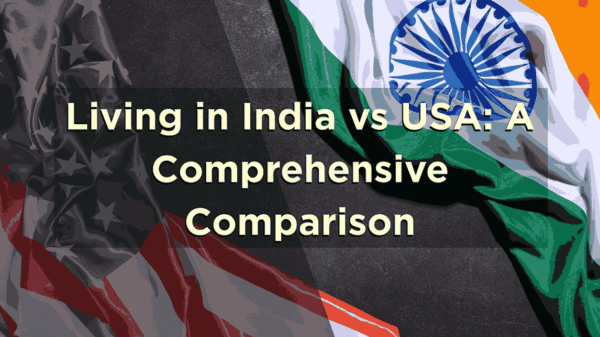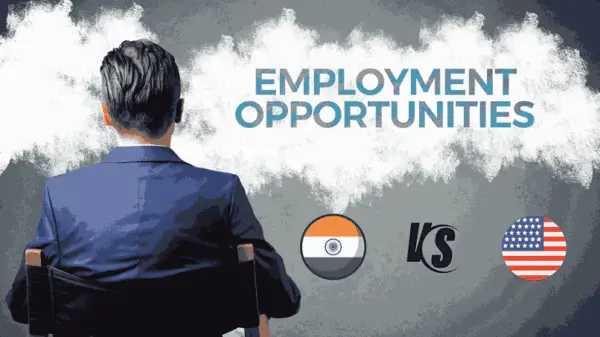Introduction
Living in India vs USA is a primary life choice that can significantly impact one’s lifestyle, finances, career, and overall well-being. Whether moving for work, education, or family, understanding the differences between these two countries is crucial. This comprehensive comparison explores essential factors to help you make an informed decision.

Cost of Living
Housing and Rent
Housing is a major expense in India compared to the USA. In the USA, renting a one-bedroom apartment in a city centre ranges from $1,500 to $3,000. In India, similar accommodations cost between $300 and $600. Rural areas are cheaper in both countries, but the USA remains significantly more expensive overall.
Utilities and Internet
Monthly utility bills in the USA average $150 to $200, while in India, they cost around $30 to $50. Internet costs are also higher in the USA. This highlights one of the stark contrasts in living in India vs USA—daily essentials are generally more affordable in India.
Transportation Expenses
Transportation habits differ widely. Car ownership is common in the USA, leading to high fuel, insurance, and maintenance costs. In contrast, India offers affordable public transport options like buses, trains, and auto-rickshaws, making commuting less expensive.
Food and Dining
Grocery and dining costs are much higher in the USA. Monthly grocery bills for one person can be $200 to $400 in the USA, compared to $100 to $150 in India. Eating out is also significantly cheaper in India, making food an essential point when comparing living in India vs USA.
Healthcare Costs
Healthcare in the USA is high-quality but expensive, especially without insurance. Health insurance premiums can cost $200 to $600 per month. In India, healthcare is more affordable and accessible in urban areas, though quality may vary. This makes a big difference when comparing living in India vs the USA for long-term medical needs.
Employment Opportunities and Work Culture

Job Market Overview
The USA offers a robust job market in technology, finance, and healthcare. India’s job market is growing, especially in IT and services, but competition is more intense. Living in India vs USA often comes down to the nature and availability of job opportunities.
Work-Life Balance
Work culture in the USA generally involves a 40-hour workweek, with a strong emphasis on productivity. In India, work hours can be longer, especially in the private sector. However, both countries are increasingly prioritising work-life balance.
Salary Comparisons
Salaries in the USA are higher in nominal terms, but the gap narrows when adjusted for purchasing power. A software engineer in the USA might earn $100,000 annually, while the same role in India pays around $20,000. However, with lower living costs, the standard of living can be comparable.
Education Systems
Primary and Secondary Education
Both countries have public and private education systems. Access to quality schooling in India can depend heavily on location and income. In the USA, public schools are funded by local taxes, leading to regional differences in quality.
Higher Education
The USA is known for world-renowned universities but has high tuition costs. In contrast, India offers more affordable higher education, though opportunities for global exposure and research may be limited. For students, the decision to live in India vs. the USA often hinges on budget and academic goals.
Healthcare Systems
Accessibility and Quality
The USA leads in medical technology and specialist care, though costs can be prohibitive. India generally provides a mix of public and private care at lower prices. Quality and accessibility vary significantly between rural and urban areas.
Health Insurance
Health insurance is essential in the USA to avoid massive medical bills. In India, insurance is growing but still underutilised. Many people rely on out-of-pocket healthcare payments.
Cultural Differences
Social Norms and Etiquette
Living in India vs. the USA means navigating different cultural values regarding social life. The USA values individualism and informal interactions, while India emphasises community, family, and respect for hierarchy.
Festivals and Holidays
India celebrates various cultural and religious festivals such as Diwali, Holi, and Eid. The USA has fewer but nationally recognised holidays like Thanksgiving and Independence Day. Festivals in India are often more communal and vibrant.
Food and Cuisine
Indian cuisine is diverse and rich in spices and regional variations. In the USA, food culture is influenced by international communities, and fast food is typical. Meals in India are often shared, while the USA tends toward individual servings.
Lifestyle and Leisure
Entertainment Options
The USA offers extensive entertainment, from theme parks to live sports and global music acts. India also has a dynamic entertainment scene, with Bollywood and regional cinema dominating. Your experience living in India vs USA will significantly depend on personal interests and access to leisure options.
Shopping and Consumer Behaviour
Shopping in the USA centres on malls and large retail chains, and credit cards are widely used. India blends traditional markets with modern malls, and bargaining is still common. Online shopping is growing rapidly in both countries.
Travel and Tourism
India offers a rich cultural heritage and historical sites, while the USA provides vast landscapes and national parks. Travel is more affordable in India, though the USA provides better road and long-distance infrastructure.
Safety and Security
Crime Rates
Gun-related crimes are more common in the USA, whereas India faces issues like petty theft and scams. Safety can vary greatly depending on the city or both countries’ neighbourhoods.
Law Enforcement
Law enforcement is generally well-funded in the USA. In India, police forces can be under-resourced, sometimes affecting response times. Trust in law enforcement varies based on personal experience and local governance.
Environmental Factors
Climate and Weather
Both countries have diverse climates. India experiences intense monsoons and hot summers, while the USA has everything from arctic winters to tropical heat. Climate plays a key role in deciding whether to live in India or the USA.
Pollution Levels
Pollution is a serious issue in Indian cities like Delhi. Due to stricter regulations, the USA generally has better air and water quality, although industrial zones can still pose problems.
Social Support Systems
Community and Family Structures
Indian Society: Family plays a central role in Indian life. Joint families are ordinary, and extended family support is strong. Elder care is usually handled within the household.
USA Society: The USA is more individualistic, with nuclear families being the norm. Children often move out by 18 and live independently. Social services and senior care facilities play a larger role.
Conclusion
The choice between living in India vs USA involves weighing personal priorities such as cost of living, job opportunities, cultural preferences, and healthcare needs. Each country offers distinct advantages and challenges. For some, the USA’s structured systems and higher salaries are appealing. For others, the community life, affordability, and family ties in India offer greater fulfilment. Understanding these key differences will help you decide what best suits your goals and lifestyle.
